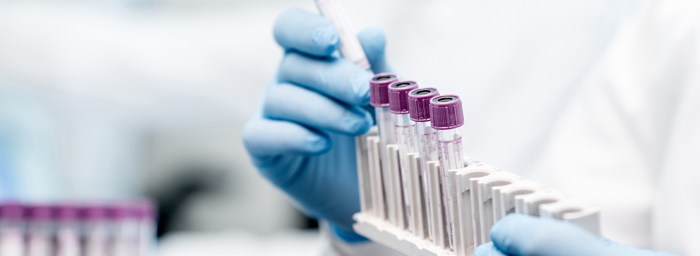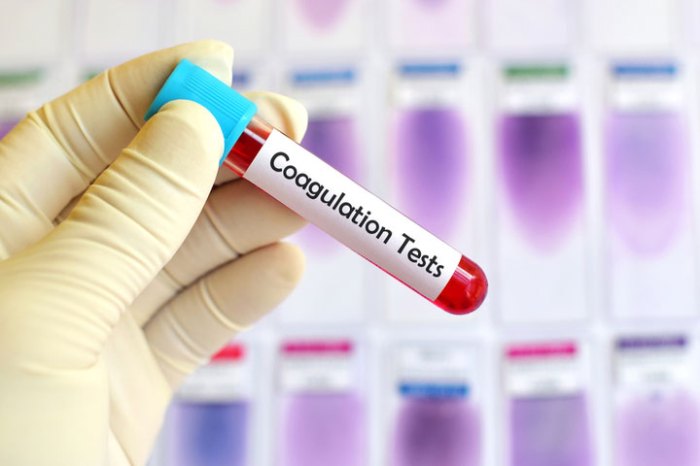A coagulation test requiring 3ml – In the realm of medical diagnostics, the coagulation test requiring 3ml stands out as a crucial tool for evaluating blood clotting function. This test provides valuable insights into the intricate mechanisms of hemostasis, the body’s natural ability to control bleeding.
By analyzing a small sample of blood, the 3ml coagulation test can unveil underlying bleeding disorders, aiding in timely diagnosis and effective management.
This comprehensive overview delves into the purpose, procedure, interpretation, advantages, disadvantages, clinical applications, and frequently asked questions surrounding the 3ml coagulation test. With its concise yet informative approach, this guide empowers healthcare professionals and patients alike with a thorough understanding of this essential diagnostic tool.
Introduction

A coagulation test, also known as a clotting test, is a laboratory procedure that measures the ability of blood to clot. It is used to diagnose bleeding disorders, such as hemophilia and von Willebrand disease, and to monitor the effectiveness of anticoagulant therapy.
There are many different types of coagulation tests, each of which measures a different aspect of the clotting process. Some of the most common coagulation tests include:
- Prothrombin time (PT): Measures the time it takes for blood to clot after the addition of thromboplastin, a substance that triggers the clotting process.
- Partial thromboplastin time (PTT): Measures the time it takes for blood to clot after the addition of partial thromboplastin, a substance that triggers the clotting process in the intrinsic pathway.
- Activated partial thromboplastin time (APTT): Measures the time it takes for blood to clot after the addition of activated partial thromboplastin, a substance that triggers the clotting process in both the intrinsic and extrinsic pathways.
- Fibrinogen assay: Measures the amount of fibrinogen in the blood, a protein that is essential for the formation of blood clots.
- Platelet count: Measures the number of platelets in the blood, which are cells that are essential for the formation of blood clots.
Coagulation tests are important for diagnosing bleeding disorders and for monitoring the effectiveness of anticoagulant therapy. They can also be used to screen for bleeding disorders before surgery or other procedures that may increase the risk of bleeding.
The 3ml Coagulation Test: A Coagulation Test Requiring 3ml

The Procedure
The 3ml coagulation test is a laboratory test that measures the time it takes for a blood sample to clot. It is used to assess the function of the blood’s clotting factors. The test is performed by drawing a blood sample from a vein in the arm and placing it in a test tube.
The tube is then incubated at 37 degrees Celsius for 30 minutes. After 30 minutes, the tube is tilted to a 45-degree angle and observed for clot formation. The time it takes for the clot to form is recorded as the clotting time.
Interpretation
The normal clotting time for the 3ml coagulation test is 5-10 minutes. A prolonged clotting time may indicate a deficiency in one or more of the blood’s clotting factors. This can be caused by a number of conditions, including hemophilia, liver disease, and vitamin K deficiency.
A shortened clotting time may indicate a hypercoagulable state, which is a condition in which the blood is more likely to clot. This can be caused by a number of conditions, including cancer, pregnancy, and certain medications.
Advantages and Disadvantages of the 3ml Coagulation Test

The 3ml coagulation test is a simple and convenient method for assessing the coagulation status of a patient. It requires only a small sample of blood and can be performed in a doctor’s office or clinic. The test is also relatively inexpensive and can be used to screen for a variety of bleeding disorders.
Advantages of the 3ml Coagulation Test
- Simple and convenient:The 3ml coagulation test is a simple and convenient method for assessing the coagulation status of a patient. It requires only a small sample of blood and can be performed in a doctor’s office or clinic.
- Inexpensive:The 3ml coagulation test is a relatively inexpensive test, making it a cost-effective option for screening for bleeding disorders.
- Can be used to screen for a variety of bleeding disorders:The 3ml coagulation test can be used to screen for a variety of bleeding disorders, including hemophilia, von Willebrand disease, and platelet disorders.
Disadvantages of the 3ml Coagulation Test
- Less sensitive than other coagulation tests:The 3ml coagulation test is less sensitive than other coagulation tests, such as the activated partial thromboplastin time (APTT) and the prothrombin time (PT). This means that it may not be able to detect all bleeding disorders.
- Can be affected by a number of factors:The 3ml coagulation test can be affected by a number of factors, including the patient’s age, sex, and race. This can make it difficult to interpret the results of the test.
Comparison of the 3ml Coagulation Test to Other Types of Coagulation Tests, A coagulation test requiring 3ml
The 3ml coagulation test is a simple and convenient method for assessing the coagulation status of a patient. However, it is less sensitive than other coagulation tests, such as the APTT and the PT. This means that it may not be able to detect all bleeding disorders.
Additionally, the 3ml coagulation test can be affected by a number of factors, making it difficult to interpret the results of the test.
For these reasons, the 3ml coagulation test is not the best choice for all patients. In some cases, it may be necessary to perform other coagulation tests, such as the APTT or the PT, to get a more accurate assessment of the patient’s coagulation status.
Clinical Applications of the 3ml Coagulation Test

The 3ml coagulation test has various clinical applications, particularly in the diagnosis and management of bleeding disorders. It provides valuable information about the patient’s coagulation status and aids in identifying specific coagulation factor deficiencies.
One of the primary applications of the 3ml coagulation test is in the investigation of patients with a suspected bleeding disorder. By assessing the patient’s coagulation profile, healthcare professionals can determine whether there is a deficiency in one or more coagulation factors.
This information is crucial for developing an appropriate treatment plan and preventing excessive bleeding during surgical procedures or other invasive interventions.
Case Studies
Case studies illustrate the practical use of the 3ml coagulation test in clinical practice. For instance, a patient with a history of excessive bleeding after minor injuries undergoes a 3ml coagulation test. The results reveal a prolonged activated partial thromboplastin time (aPTT), indicating a deficiency in one of the coagulation factors involved in the intrinsic coagulation pathway.
Further testing confirms a deficiency in factor VIII, leading to a diagnosis of hemophilia A.
Common Queries
What is the purpose of the 3ml coagulation test?
The 3ml coagulation test is used to evaluate the clotting function of blood, providing insights into the body’s ability to control bleeding.
How is the 3ml coagulation test performed?
A small sample of blood is drawn and placed in a test tube containing a reagent that triggers clotting. The time it takes for the blood to clot is measured and compared to reference values.
What do the results of the 3ml coagulation test mean?
Abnormal results may indicate bleeding disorders, such as hemophilia or von Willebrand disease, or other underlying medical conditions that affect blood clotting.
